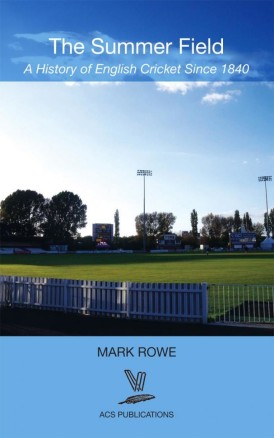The Summer Field
Martin Chandler |Published: 2016
Pages: 232
Author: Rowe, Mark
Publisher: ACS
Rating: 3.5 stars

It is an excellent choice of title, redolent of sunny afternoons sat in a garden with a decent Australian Chardonnay and the regular sound of bat and ball from a nearby village green. The subtitle is a little disconcerting, A History of Cricket, but a quick look inside allays the fears that yet another author is trying to write the story of the game. The use of the indefinite article in the sub-title is certainly significant. Not, I hasten to add, that there is anything amiss in seeking to write the history of cricket, but it has already been done, and done very well, and any modern attempt to produce a definitive volume would produce a book so large as to be unwieldy.
A further sign of reassurance came with a brief look at the index. Now that may seem an odd place to begin a book, but had there been a proliferation of entries for Broad Halfpenny Down and the names Pilch, Beldham and Nyren I might not have begun to read at all. As there were none, and just a single entry each for the name Mynn, and for the Hambledon club it soon became clear that The Summer Field was not all that it seemed.
The most prolific name in the index was that of Grace, not in itself a cause for surprise, but it was the name that was mentioned on the second greatest number of occasions that really piqued my interest. The ‘Iron Duke’, Douglas Jardine, gets a mention on no fewer than 21 occasions – more than Don Bradman and more than Garry Sobers. Some of the modern greats, men like Ricky Ponting, Brian Lara, Imran Khan and Kapil Dev aren’t referred to at all, and Sachin Tendulkar sneaks in just twice. This, I decided, was a book worth reading.
Unlike a traditional history the book also lacks any sort of chronological framework. The way it is structured is as a serious of essays that each deal with a discrete part of the game. There are 24 chapters in all ranging from the obvious subjects dealing with the way the game is played, such as batting, fielding and umpiring. Also dealt with is the manner in which cricket is organised, and a nod towards the women’s game. Although the book is essentially about England there is a chapter entitled Australia, but essentially only in the context of the continuing rivalry between the two countries.
There are also glimpses of subjects well outside the mainstream of topics that generally fill books with similar content. Examples are the chapters on the private lives of cricketers, on journalism and on those who watch cricket. I would stress there is nothing salacious about either of the former two, and no remarkable revelations, but a good deal of interesting material on aspects of the game that rarely attract too much attention.
The most welcome aspect of The Summer Field is the perspective from which it approaches its task – no book setting out to provide a standard work of reference on the history of cricket would not use Haygarth’s monumental Scores and Biographies as a source, nor refer to Wisden only half a dozen times, and then only in passing. Much more prevalent as source material for Mark Rowe are provincial newspapers and county yearbooks, particularly those of the East Midlands area.
There is much of interest in The Summer Field, a book I found absorbing and well written. There is nothing in the way of dismantling perceived wisdom, well at least not by dint of painstaking research. There is however a chapter entitled The Myth of the ‘Golden Age’ which I found to be something of a reality check. It is not difficult for those of us who have been brought up on the writings of the likes of Sir Neville Cardus to buy into the notion that all amateur batsmen who played the game between 1890 and the outbreak of the Great War were dazzling strokemakers. But of course in truth only a handful were, and there was doubtless as much pedestrian cricket played between hard bitten professional players as ever there has been. As well that the message got through now I suppose.






Leave a comment